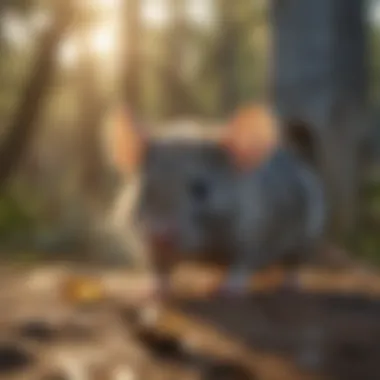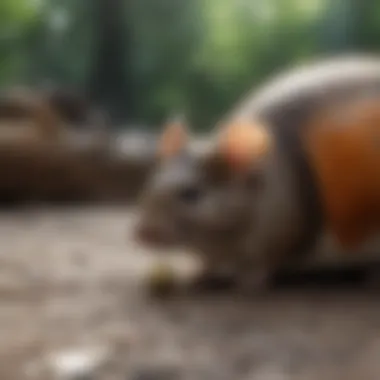Optimal Baiting for Effective Mouse Traps


Intro
This guide aims to provide a comprehensive understanding of mouse behavior and the best baiting techniques for effective pest control. Knowing what attracts mice will assist in choosing the right bait for traps. Mice are not just pests; they have specific behaviors and preferences that can be utilized in selecting baits. The following sections will explore these aspects in detail, enriching the approach to rodent management.
Animal Overview
Mice belong to the family Muridae, one of the largest and most diverse families of rodents. They are commonly found in various environments, and their behaviors can vary based on species and habitat. Understanding the species involved can significantly enhance pest control strategies.
Common Names
Some common names related to mice include:
- House Mouse
- Field Mouse
- Deer Mouse
Scientific Classification
Mice fall under the following scientific classification:
- Kingdom: Animalia
- Phylum: Chordata
- Class: Mammalia
- Order: Rodentia
- Family: Muridae
- Genus: Mus
Geographic Range
Mice are found across the globe. They adapt to urban, suburban, and rural settings, which contributes to their widespread presence. Some species are native to specific regions, while others have been introduced to new areas due to human activity. Their ability to thrive in diverse habitats makes managing their population a challenging task.
Behavior and Social Structure
Understanding mouse behavior is crucial for effective bait selection. They exhibit specific social behaviors and communication patterns that are significant in pest control strategies.
Social Behavior
Mice are generally social animals. They often live in groups, which can lead to quicker population growth and spreading. Their social structure is based on hierarchies, which can influence how they interact with each other and their environment.
Communication
Mice communicate primarily through sounds, scent marking, and body language. These communication methods are essential in establishing territory and signaling danger. Understanding these signals can aid in identifying areas with higher rodent activity.
Mating and Reproduction
Mice are prolific breeders. A female mouse can produce several litters in a year, often leading to rapid population increases. This reproductive capability necessitates quick and effective control methods to manage infestations.
Habitat and Ecosystem
Mice occupy various habitats, which influences their food sources and roles in the ecosystem. This knowledge can significantly inform baiting strategies for traps.
Natural Habitat
Mice thrive in environments that provide shelter and food. They can adapt to forests, fields, urban buildings, or any area offering potential nesting spots. The versatility of their habitat choices is a reason for their enduring presence.
Food Sources and Diet
Mice are omnivorous, consuming a range of foods from grains to insects. Their diet often includes items found in human environments, which can be leveraged when selecting bait. Common food preferences include:
- Seeds
- Fruits
- Grains
Role in Ecosystem
Mice play a role in the ecosystem as prey for various predators. They help in seed dispersal, contributing to plant growth. However, their numbers can pose challenges in human habitats, highlighting the need for effective management practices.
Understanding the dietary preferences and behaviors of mice is key to selecting bait that effectively attracts them, ensuring better success in controlling their populations.
Understanding Mouse Behavior
Understanding the behavior of mice is integral to effective bait selection and trap setup. Knowledge about how mice forage, what attracts them, and their natural tendencies can significantly enhance the success rate of pest control methods. The nuances in the behavior of these rodents inform strategies that resonate with their innate instincts, thus fostering a more effective approach to trapping.
Natural Diet of Mice


Mice are omnivorous creatures, which means they consume a variety of foods. Their diet primarily consists of seeds, fruits, grains, and insects. In urban environments, mice often adapt by scavenging leftovers from human food. This adaptability is pivotal for pest control, as it suggests that bait mimicking their natural dietary preferences could be more effective.
When selecting bait for traps, it's important to consider the natural food sources available in the surrounding environment. For instance, if a region has an abundance of grains, bait with similar properties might yield better results. Mice are also attracted to certain food scents that can enhance bait efficacy. Recognizing these dietary tendencies can help in devising an optimal baiting strategy.
Scent Attraction Mechanisms
Mice have a highly developed sense of smell, which plays a crucial role in their feeding behavior. This olfactory prowess allows them to detect food from considerable distances. In terms of bait, scents can be categorized into two primary types: direct food scents and pheromonal scents.
Direct food scents include the aromas that emanate from potential food sources, such as peanut butter or cheese. Pheromonal scents, on the other hand, are chemical signals used in communication between mice. These scents may indicate other mice’s presence or alert them to an available food source. By combining appealing food scents with an understanding of these pheromonal cues, one can enhance the trapping bounty.
It is essential to rotate baits and scents regularly to maintain effectiveness. If a scent becomes associated with danger, mice may become wary and avoid it. Freshness in bait and the strategic use of scent can maximize interest and encourage traps effectiveness.
Feeding Habits and Preferences
Mice display certain feeding habits that can influence bait choice. They tend to feed at dusk or dawn when they feel safer from predators. This behavior suggests timing traps accordingly might increase their chances of success. Moreover, mice often prefer small quantities of food throughout the day rather than large meals. Therefore, using smaller amounts of bait can align with their natural feeding behavior.
Understanding particular preferences can also be beneficial. For example, some mice show a stronger attraction to protein-rich foods like peanut butter over carbohydrate-rich foods like bread. Conducting experiments with different types of bait may reveal specific preferences unique to the mouse population in a given area.
Types of Mouse Traps
Understanding the various types of mouse traps is critical for effective rodent management. Each type of trap comes with its own advantages and limitations, tailored for different scenarios and user preferences. Knowing how to utilize these options can significantly impact your success in catching mice.
Snap Traps
Snap traps are one of the most traditional and widely used methods for rodent control. Their design typically consists of a spring-loaded mechanism that delivers a quick and lethal strike. This efficiency makes them popular among homeowners and pest control professionals alike.
Benefits
- Effectiveness: Snap traps have a high success rate in capturing mice swiftly.
- Reusability: Many snap traps are designed to be reused, which can save costs in the long run.
- Non-toxic: Unlike poison, snap traps do not pose secondary risks to pets or children.
Considerations
When using snap traps, placement is key. Traps should be positioned along known mouse pathways and near food sources. It is essential to lure the mice effectively with the right bait to increase the chances of capture. Snap traps also require routine checking to ensure that traps are functioning and to remove any caught mice promptly.
Glue Traps
Glue traps are another option that relies on a sticky surface to capture mice. When a mouse steps onto the trap, it becomes adhered and cannot escape. While they are easy to use and set up, they do present some ethical concerns.
Benefits
- Ease of Use: Glue traps require no complex setup and are easy to discard once full.
- Sensitive to Movement: They can catch smaller or younger mice that may not trigger snap traps.
Considerations
- Humaneness: Glue traps can cause distress to animals, as they may suffer before ultimately dying.
- Limitations: They may not work effectively in humid environments, as moisture can cause the adhesive to weaken.
- Bycatch Risk: Other animals, such as non-target species, may become trapped, raising ethical concerns.
Electronic Traps
Electronic traps represent a more modern solution for rodent control. These devices deliver a quick electric shock to kill mice instantly. While they may require an initial investment, their efficiency can make them worthwhile.
Benefits
- Quick Dispatch: Electronic traps eliminate mice in seconds, minimizing suffering.
- Sanitary: These traps contain the dead mouse, preventing mess and reducing exposure to disease.
Considerations
- Power Source: Most electronic traps need batteries or a power source, which can limit their usability in some locations.
- Maintenance: Regular battery changes and cleanliness are necessary for optimal performance.
In summary, selecting the right type of trap is essential for successful mouse control. The decision may depend on personal preference, environmental considerations, and ethical concerns. A well-informed choice can greatly enhance the effectiveness of any pest management strategy.
Common Types of Bait for Mouse Traps
Understanding Common Types of Bait for Mouse Traps is essential for effective mouse control. The right bait can significantly increase the likelihood of trapping mice quickly. Mice are driven by hunger, and selecting the optimal bait can exploit their natural feeding habits. This section will look at various bait options, analyzing their benefits and considerations, which can help homeowners and property managers make informed decisions.
Peanut Butter
Peanut butter is one of the most favored choices for bait. Its strong scent can attract mice from a distance, making it a highly effective option. The sticky texture also ensures that mice cannot easily remove it from the trap without triggering it.


When using peanut butter, it is vital to apply a modest amount. Overloading the bait can result in spills, which may discourage mice from approaching the trap later. Additionally, peanut butter provides a good source of energy for the mice, aligning with their natural cravings. This bait is generally recommended for snap traps and glue traps, as it adheres well and remains fresh for an extended period.
Cheese
Contrary to popular belief, cheese is not the most effective bait. While it may be appealing due to cultural portrayals, mice generally prefer sweeter and more aromatic substances. However, it can still work in some situations, mainly if other options are limited. Soft cheeses, such as cream cheese, often yield better results due to their strong odor and easy accessibility for mice.
It is important to consider that cheese can spoil faster than other baits. For this reason, it is less ideal for prolonged trapping scenarios. Careful monitoring is needed if cheese is chosen as the bait, ensuring it does not become rancid or unappealing.
Seeds and Nuts
Seeds and nuts are a natural choice for bait, as they are a part of a mouse’s diet. For example, sunflower seeds and almonds can be appealing. Mice are motivated by the nutritional value they provide, making them highly attractive.
This bait type often requires a bit more finesse in placement. Mice are more likely to approach a trap when they feel safe and secure. Seeds and nuts can be placed in small quantities near the trap or used to create a bait station. The key is to ensure it is fresh, as stale nuts may deter mice from returning.
Fruits
Certain fruits, such as apple slices or grapes, can be enticing to mice. The sweetness and moisture content may attract them. However, they can also create a mess and begin to rot quickly, which can deter mice as well. It is advisable to cut fruit into small pieces to manage this issue effectively.
Fruits may not be ideal for long-term use but can be a good option in conjunction with other baits. The possibility of rotation between different bait types could enhance trapping success.
Commercial Bait Alternatives
Commercial bait alternatives have emerged as effective solutions for pest control. These products are designed specifically for rodent traps, offering specialized formulas that can be more appealing than natural bait. They often contain a mixture of ingredients that mimic the scents and tastes that attract mice.
When selecting commercial baits, it is crucial to review the ingredients and ensure they align with ethical considerations for pest control. Some commercial baits may be hazardous to non-target species or have negative environmental impacts. Thus, it is worthwhile to conduct thorough research before use.
Factors Influencing Bait Effectiveness
Understanding the factors influencing bait effectiveness is crucial for anyone dealing with rodent infestations. The right bait can significantly increase the chances of successful trapping. It's essential to consider several elements that determine how well a specific bait attracts mice. The combined effects of freshness and quality, placement and accessibility, as well as environmental considerations, all play a role in optimizing baiting strategies.
Freshness and Quality of Bait
Mice are attracted to fresh, high-quality baits. The freshness of bait impacts its scent and taste, making it essential to use items that are not expired or spoiled. For instance, using old peanut butter may not entice mice effectively.
- Fresh bait increases olfactory appeal.
- Quality should match the dietary preferences of mice.
- Regular replacement of bait is essential for sustained effectiveness.
Higher quality bait often contains ingredients that mimic a mouse's natural diet, enhancing their interest. Properly storing bait before use can help maintain its freshness.
Placement and Accessibility
The placement of bait is as critical as the bait itself. Mice tend to travel along walls and in hidden areas. Understanding these pathways will enhance your trapping success. Baits should be placed:
- Near known entry points, like holes or gaps.
- In secluded spots where mice feel secure.
- Away from human activity to prevent disturbances.
Accessibility is vital. If a bait is too difficult for a mouse to reach, it will not be effective. Consider the height and distance of the trap from designated mouse pathways.
Environmental Considerations
Environmental factors play an undeniable role in bait effectiveness. The surrounding conditions can affect how quickly a bait loses its appeal. Mice are sensitive to their environment; thus:
- Weather can affect bait integrity, especially in outdoor settings.
- Nearby food sources can decrease bait attractiveness.
- Seasonal changes may shift dietary preferences.
Being aware of these factors can help you decide when and where to place bait. For example, during colder months, mice may seek out warmer places, which can help in bait placement strategies.
In summary, effectively using bait involves understanding its freshness, optimal placement, and environmental dynamics. Consider these aspects to enhance your pest control strategies.
Innovative Bait Strategies
Innovative bait strategies play a significant role in enhancing the effectiveness of mouse traps. Traditional baiting methods may not always yield successful results, especially in environments where mice have become wary of commonly used baits. By employing innovative techniques, you can increase your chances of drawing mice into traps and securing a successful catch. This section explores three key innovative strategies that can lead to improved results in pest control efforts.
Combining Baits for Maximum Attraction
Combining different types of baits has proven beneficial in many scenarios. Mice have diverse food preferences, and a mixture of baits can address a variety of appetites. For example, peanut butter can be combined with small bits of dried fruit or seeds. The sweet scent of fruit may attract mice, while peanut butter serves as a strong protein source.
Consider these points when combining baits:
- Flavor Variety: Different flavors can appeal to various mouse populations.
- Texture Differences: Mixing soft and hard baits might entice mice who prefer different chewing experiences.
- Odor Layers: Combining baits creates an aromatic signature that can be more enticing than individual options.


By experimenting with bait combinations, you may find a mix that significantly increases trap effectiveness.
Using Scents to Enhance Bait Appeal
Scent is a powerful tool in attracting mice to traps. As sensitive creatures, mice rely on their sense of smell to find food. Enhancing bait with additional scents can make it much more attractive. For instance, adding a few drops of vanilla extract to peanut butter can provide a sweet aroma that mice are drawn to.
Essential oils like peppermint or eucalyptus can also serve dual purposes. They can mask other scents in the environment and entice mice due to their strong odors. Consider the following when using scents:
- Natural vs. Synthetic: Opt for natural scents which may resonate more with the mice.
- Scent Timing: Apply scents just before baiting to maintain freshness.
- Environmental Integration: Be mindful of any other strong smells that may either compete with or help the bait's aroma.
Selecting Baits Based on Seasonal Variations
Mice’s feeding habits often shift with the seasons, influenced by their natural diet. Understanding these variations can help you select the most effective baits throughout the year. In warmer months, mice may lean more towards fresh fruits and seeds, while in colder months, they might search for high-energy food sources like nuts and grains.
Take these seasonal considerations into account:
- Spring and Summer: Fresh fruits, grains, and garden vegetables work effectively.
- Fall and Winter: Dried foods such as nuts and concentrated protein sources like beef jerky are preferred.
- Feeding Patterns: Monitor local food sources that may influence mouse behavior to adapt bait selection accordingly.
Implementing these innovative bait strategies can elevate your rodent control efforts, addressing the adaptability of mice and leading to more successful trapping outcomes.
Cautions and Ethics of Bait Use
In pest control, particularly with mouse trapping, the selection and use of bait require careful consideration. Not only does it reflect a strategy for effective rodent management, but it also raises ethical questions. Understanding the potential implications of bait use is essential for ensuring humane practices and minimizing negative impacts on surrounding ecosystems. Ethical considerations instill a sense of responsibility in individuals dealing with pest control, ensuring that actions taken do not lead to unintended consequences.
Addressing Non-Target Species
Using bait in mouse traps necessitates awareness of non-target species. These can include pets, birds, or other wildlife that may come into contact with the bait. For instance, peanut butter may attract not only mice but also squirrels or birds. To mitigate these risks, it is crucial to secure bait in a way that only allows access to mice. Specialized trap designs can help in minimizing accidental harm to non-target animals.
Moreover, employing bait types that are less appealing to other species can be beneficial. For example, seeds specifically chosen for their attractiveness to mice, while being less enticing for birds, can reduce the likelihood of unintended captures. Thus, it is vital to think beyond immediate goals and consider the broader implications of choices made.
Impact of Bait on Local Ecosystems
The selection of bait can have a direct impact on local ecosystems. Certain baits might contain substances that, while effective for rodent attracting, can prove harmful for other wildlife. For instance, using certain processed food items could lead to secondary poisoning or resource depletion among non-target species. This is particularly important in biomes where species balance is delicate.
The use of synthetic baits that may not break down naturally poses additional challenges. These can contribute to environmental pollutants, impacting soil and water quality over time. Therefore, it is advisable to prioritize natural or organic bait options, as they are less likely to disrupt local ecosystems. Making informed choices regarding bait can promote healthier environments, ultimately benefiting biodiversity.
Regulatory Compliance for Pest Control Methods
Lastly, understanding the regulatory landscape surrounding pest control methods is critical. Many regions have specific laws and guidelines governing the use of baits in traps. Compliance not only ensures legality but also guarantees adherence to humane practices. Regulations may dictate the types of bait that can be used, as well as the methods of trapping employed.
Understanding these regulations is essential for responsible pest control. Individuals should always consult local guidelines, which can often be found in resources such as en.wikipedia.org or pertinent governmental websites. Engaging with these requirements fosters a sense of professionalism and accountability within pest control practices, ultimately enhancing the integrity of the field.
In summary, a thorough understanding of the cautions and ethics surrounding bait use is crucial. Considerations regarding non-target species, the impact on ecosystems, and compliance with regulations form the backbone of responsible pest control. By prioritizing these elements, individuals can foster humane and effective rodent management practices.
Concluding Recommendations
Concluding the guide on baiting for mouse traps is essential to ensure effective pest management. This section ties together the insights provided throughout the article and offers actionable steps for individuals dealing with rodent issues. The reasons for focusing on concluding recommendations are manifold. It not only summarizes the key points discussed in previous sections but also provides clarity on the best practices that can enhance bait efficacy and overall rodent control strategies.
Bait Selection Best Practices
Choosing the right bait is central to trapping success. Here are some best practices for selecting baits:
- Understand Mouse Preferences: Familiarize yourself with the natural diet of mice. Foods they are naturally inclined to seek will be more effective. Peanut butter is often favored due to its strong aroma and calorie content.
- Use Variety: Don’t stick to one single type of bait. Try a combination of different food items such as seeds, nuts, and fruits to determine what works best in your specific situation.
- Make it Accessible: Ensure that the bait is easily obtainable for mice. Place it in strategic locations where you've seen signs of activity.
- Regular Bait Changes: Replace bait regularly to maintain its freshness and prevent odors that may deter mice.
Implementing these practices increases the chances of successful trapping and minimizes the risk of mouse infestations.
Maintaining a Clean Environment
A clean environment plays a vital role in rodent control. It's crucial for the following reasons:
- Reduction of Attractants: Mice are drawn to clutter and remnants of food. By keeping areas tidy, you reduce the attractive elements that might otherwise draw them in.
- Improved Trap Efficiency: When the surroundings are clean, it becomes easier to identify where mice are active, allowing for more strategic placement of traps and bait.
- Preventing Re-Infestation: Continuous cleanliness deters mice from returning. This not only includes indoor spaces but also the immediate perimeter of your establishment.
In essence, maintaining a clean environment is an ongoing commitment that complements effective baiting strategies.
Further Reading on Effective Rodent Control
For those interested in a deeper dive into rodent control, further resources can provide invaluable knowledge. Some recommended readings include:
- Wikipedia: Articles about rodent behavior and control methods can provide additional context and updated research.
- Britannica: Insightful articles that explain the ecological impact of rodents and effective management strategies.
- Reddit: Community discussions can offer personal experiences and innovative solutions for pest control.
- Facebook: Various groups dedicated to pest management often share best practices and tips.
Utilizing these resources can enhance your understanding of rodent behavior and provide innovative methods for effective control.
Knowledge is power in pest management. Understanding mouse behavior and effective trapping techniques leads to more successful outcomes.







